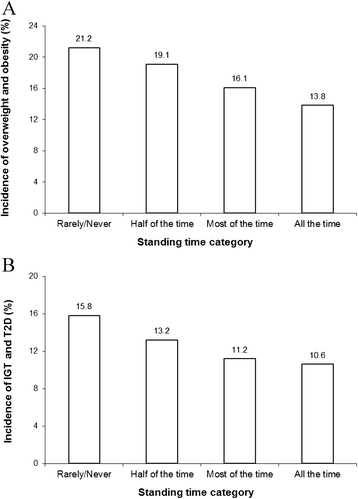Workplace standing time and the incidence of obesity and type 2 diabetes: a longitudinal study in adults
- PMID: 25885707
- PMCID: PMC4328440
- DOI: 10.1186/s12889-015-1353-x
Workplace standing time and the incidence of obesity and type 2 diabetes: a longitudinal study in adults
Abstract
Background: It is increasingly recognized that standing represents a simple solution to extended periods of sitting. However, it is currently unknown whether workplace standing time is prospectively associated with a lower incidence of chronic diseases. The objective of this study was to examine the association between workplace standing time and the incidence of overweight/obesity (OW/OB) and impaired glucose tolerance/type 2 diabetes (IGT/T2D) in adults.
Methods: A longitudinal analysis from the Quebec Family Study (Canada) was conducted on 293 participants, aged 18 to 65 years, followed for a mean of 6 years. Information on self-reported occupational standing time as well as several covariates was collected at both baseline and follow-up. Outcome measures included the development of OW/OB (i.e. body mass index ≥25 kg/m(2)) and IGT/T2D (i.e. 2-h postload plasma glucose level ≥7.8 mmol/L).
Results: The incidence rates of OW/OB and IGT/T2D over the 6-year follow-up period were 17.4% and 12.6%, respectively. Significant negative associations were observed between the amount of occupational standing time and the development of outcome measures. However, the associations were no longer significant after adjustment for age, sex, smoking habits, total annual family income, daily caloric intake, and submaximal working capacity. In age- and sex-adjusted logistic regression analysis, significant negative linear trends were observed across levels of standing time and the outcome variables. However, the associations were no longer significant after further adjustment for the other covariates. Finally, we observed that the change in standing time from baseline to year 6 was significantly associated with the development of outcome measures, with higher incidence rates in adults reporting a reduction in standing time at follow-up. However, the associations became non-significant after adjustment for covariates.
Conclusions: Greater occupational standing time is not sufficient in and of itself to prevent the development of OW/OB and IGT/T2D in adults. Future efforts are needed to better understand the potential benefits of higher amounts of standing time throughout the day on the prevention of chronic diseases.
Figures


References
Publication types
MeSH terms
Grants and funding
LinkOut - more resources
Full Text Sources
Other Literature Sources
Medical
Miscellaneous

